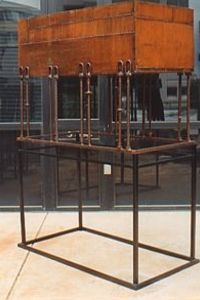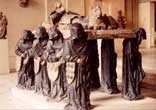
"Togu Na, Mali."
Steel. 1990. 73" x 52" x 36"
|
|
|
Subject
The
Dogon people of Mali live on the Bandiagra escarpment, a row of
cliffs stretching 125 miles parallel to the Niger River.
Every Dogon village has a Togu Na, to shelter the men as they discuss
village matters. The structure represents the shelter where the
eight primordial ancestors ( four pairs of twins ) met; each being
identified with one of the supporting pillars, which are frequently
represent him or her. The roof of the structure is millet stalks,
and the pillars are stone or wood.
The occurrence of the primordial pairs is common in Dogon sculpture,
and appears in both freestanding sculpture and sculptural decoration.
For example, in sculptures of the Primordial Couple, the pair sit
on a stool, which has four legs representing their offspring, each
of whom is both a twin, and man and woman in the same body.
Object
The
sculpture aims to recreate both the image and spirituality of the
ToguNa. The upper box represents the millet 'roof', and the eight
pillars, each of which is different, represent the Primordal ancestors.
|
| The
interesting thing about the sculpture is that, when completed, it
more closely resembled the Tomb of Philippe Pot, than a Togu Na.
|
 |
Tomb of Phillipe Pott, Grand Senechal de
Bourgogne, by Antoine le Moiturier, executed from 1477 to
1483, from the abbey church of Citeaux, Cote-d'Or, France.
Painted stone. Musee du Louvre, Paris, France. |
|
|
